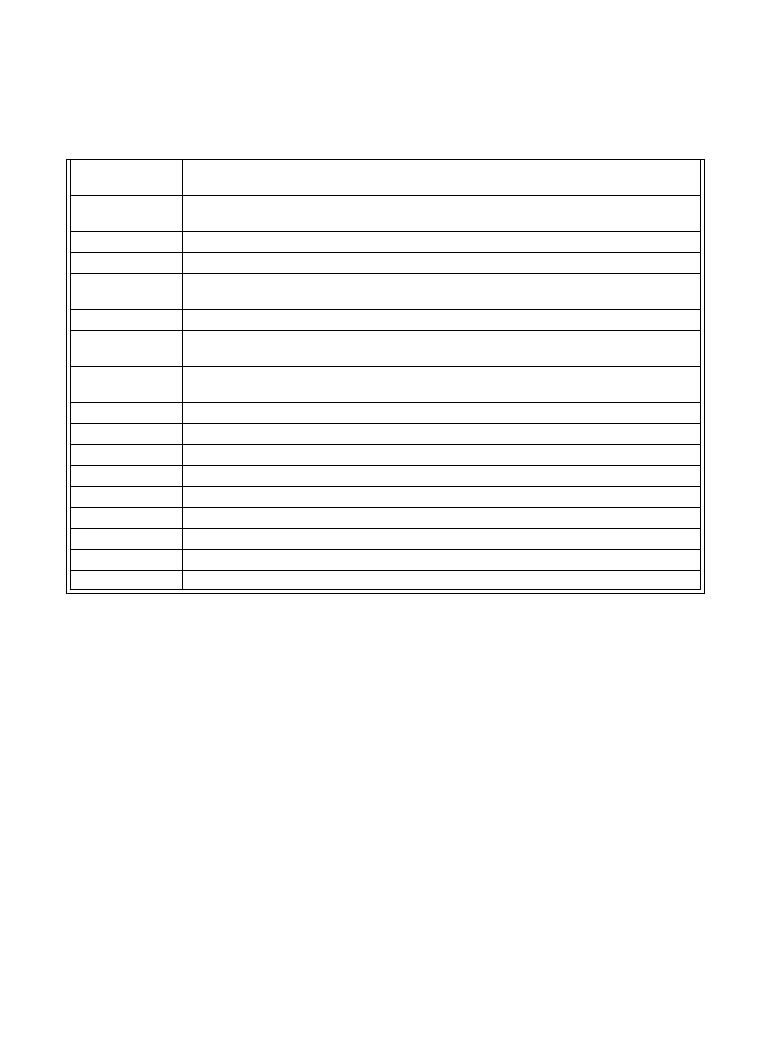ВУЗ: Казахская Национальная Академия Искусств им. Т. Жургенова
Категория: Книга
Дисциплина: Не указана
Добавлен: 03.02.2019
Просмотров: 21786
Скачиваний: 19

13-82 Standards and Practices
13.4.5 CEA Standards
The following documents relating toradio and television broadcasting have been adopted by the
Consumer Electronics Association. For additional information contact the CEA at www.ce.org.
13.4.5a
Home Networks
ANSI/EIA-600.10
: Introduction to the CEBus Standard
The EIA-600 Specification covers the overall topology of the EIA-600 network and the detailed
topology for each individual medium used; the electrical and physical specifications for the
media usable by EIA-600; the physical interface from a device to the medium and the signaling
method specifications to be used on the medium; the protocol to be used for network access and
the description of the control message format; and a command language that allows all devices to
communicate a common set of functions to be performed. Aspects of the overall EIA-600 net-
work that are not addressed in this specification are operation and maintenance of the network.
This standard establishes a minimal set of rules for compliance. It does not rule out extended ser-
vices that may be provided, as long as the rules of this standard are adhered to within the system.
EG 20-1997
Tape Transport Geometry Parameters for 19-mm Type D-2 Composite Format for Television Digi-
tal Recording
EG 21-1997
Nomenclature for Television Digital Recording of 19-mm Type D-1 Component and Type D-2
Composite Formats
EG 22-1997
Description and Index of Documents for 19-mm Type D-2 Composite Television Digital Recording
EG 23-1996
Transfer of Two-Channel Stereo Audio from Audio Magnetic Film or Tape to Video Tape
EG 24-1995
Video and Audio Alignment Tapes and Procedures for 1-in Type C Helical-Scan Television Analog
Recorders
EG 25-1996
Telecine Scanning for Film Transfer to Television
EG 26-1995
Audio Channel Assignments for Digital Television Tape Recorders with AES/EBU Digital Audio
Input
EG 27-1994
Supplemental Information for ANSI/SMPTE 170M and Background on the Development of NTSC
Color Standards (R1999)
EG 28-1993
Annotated Glossary of Essential Terms for Electronic Production
EG 29-1993
Remote Control of Television Equipment
EG 30-1995
Implementation of ESlan Standards
EG 31-1995
Considerations for Cassette Bar Code Readers
EG 32-1996
Emphasis of AES/EBU Audio in Television Systems and Preferred Audio Sampling Rate
EG 33-1998
Jitter Characteristics and Measurements
EG 34-1999
Pathological Conditions in Serial Digital Video Systems
EG 35-1999
Time and Control Code Time Address Clock Precision for Television, Audio and Film
EG 36
Transformations Between Television Component Color Signals
SMPTE Standards, Recommended Practices, and Engineering Guidelines by Number
Downloaded from Digital Engineering Library @ McGraw-Hill (www.digitalengineeringlibrary.com)
Copyright © 2004 The McGraw-Hill Companies. All rights reserved.
Any use is subject to the Terms of Use as given at the website.
Audio/Video Standards

Audio/Video Standards 13-83
It is, in fact, the intention of the standards to permit extended services (defined by users) to exist.
ANSI/EIA-600.31
: Power Line Physical Layer and Medium Specification (ANSI/EIA-
600.31-97)
This document is the preliminary specification for the CEBus Power Line (PL) Physical Layer
and Media portion of the Physical Layer and Media Specifications of EIA-600. Its purpose is to
present the information necessary for the development of a PL physical network and devices to
communicate and share information over the network. This is one of a series of documents cov-
ering the various media that comprise the CEBus standard.
ANSI/EIA-600.32
: Twisted Pair Physical Layer and Medium Specification (ANSI/EIA-
600.32-97)
This document is the specification for the CEBus Twisted Pair (TP) Physical Layer and Medium.
Its purpose is to present all the information necessary for the development of a TP physical net-
work and devices to communicate and share information over that network in an orderly manner.
This is one of a series of documents covering the various media that comprise the CEBus stan-
dard.
ANSI/EIA-600.33
: Coax Cable Physical Layer and Medium Specification (ANSI/EIA-
600.33-97)
This document is the preliminary specification for the CEBus Coax (CX) Physical Layer and
Medium. Its purpose is to present all the information necessary for the development of a CX
physical network and devices to communicate and share information over that network in an
orderly manner. This is one of a series of documents covering the various media that comprise
the CEBus standard.
ANSI/EIA-600.34
: IR Physical Layer and Medium Specification (ANSI/EIA-600.34-97)
This document is a preliminary specification for the CEBus Infrared (IR) Physical Layer and
Medium portion of the Physical Layer and Medium specifications of EIA-600. Its purpose is to
present all the information necessary for the development of a IR physical network and devices
to communicate and share information over that network to and from IR and other CEBus media
in an orderly manner. This is one of a series of documents covering the various media that com-
prise the CEBus standard.
ANSI/EIA-600.35
: RF Physical Layer and Medium Specification (ANSI/EIA-600.35-97)
This document is the preliminary specification for the CEBus Radio Frequency (RF) Physical
Layer and Medium portion of the Physical Layer and Medium specifications of EIA-600. Its pur-
pose is to present all of the information necessary for the development of a RF physical layer for
the CEBus device. This is one of a series of documents covering various media that comprise the
CEBus standard.
ANSI/EIA-600.37
: Symbol-Encoding Sublayer
This document describes the portion of the Node Physical Layer that interfaces to the Medium
Access Control (MAC) Sublayer and to Layer System Management (LSM). This sublayer is
called the Symbol Encoding (SE) Sublayer.
Downloaded from Digital Engineering Library @ McGraw-Hill (www.digitalengineeringlibrary.com)
Copyright © 2004 The McGraw-Hill Companies. All rights reserved.
Any use is subject to the Terms of Use as given at the website.
Audio/Video Standards

13-84 Standards and Practices
ANSI/EIA-600.38
: Power Line/Radio Frequency Symbol Encoding Sublayer
This document describes the portion of the Power Line or RF Physical Layer that interfaces to
the Medium Access Control (MAC) Sublayer and to Layer System Management (LSM). This
sublayer is called the Power Line/RF Symbol Encoding (PL/RF SE) Sublayer.
ANSI/EIA-600.41
: Description of the Data Link Layer (ANSI/EIA-600.41-97)
This document provides a prose description of the Data Link Layer Design for the CEBus Net-
work. The intent of this document is to be descriptive, rather than provide a formal specification,
and contains a discussion of the Data Link Layer interfaces to the Network Layer and Physical
Layer, as well as a functional description of the Data Link Layer.
ANSI/EIA-600.42
: Node Medium Access Control Sublayer (ANSI/EIA-600.42-97)
This part of the CEBus standard is a technical specification of the services and protocol for the
Node Medium Access Control Sublayer.
ANSI/EIA-600.43
: Node Logical Link Control Sublayer (ANSI/EIA-600.43-97)
This part of the CEBus standard is a technical specification of the services and protocol for the
Node Logical Link Control Sublayer.
ANSI/EIA-600.45
: Node Network Layer Specification
This document is the CEBus Node Network Layer part of EIA-600.
ANSI/EIA-600.46
: Node Application Layer Specification
This document is the CEBus Node Application Layer part of EIA-600.
ANSI/EIA-600.81
: Common Application Language (CAL) Specification (ANSI/EIA-
600.81-97)
This document describes the basic framework of CAL. It is intended as an introduction to CAL
operation and syntax that stresses the object-oriented aspects of CAL. It is believed that the
object-oriented methodology offers the best means of understanding the complex interaction
between devices, controls, and controllers present in the CEBus environment.
ANSI/EIA-600.82
: CAL Context Description (ANSI/EIA-600.82-97)
This document describes the contexts, or main subsystems within a device, supported by the
Common Application Language (CAL).
ANSI/EIA-633.10
: Introduction to EIA-600 Conformance Specification
This standard is concerned with conformance of an implementation to the associated protocol
specifications contained in EIA-600. A dual audience is expected for this standard. The first is
laboratories that may be interested in acting as conformance testing agencies. Such agencies are
tasked with converting these requirements into a hardware/software test system. The second
audience is the set of designers of EIA-600 compatible products. Any designer of compatible
products should understand the importance of the tests described in this standard, as they relate
to implementing EIA-600. The second group should read this standard while considering
whether its hardware and/or software implementation is likely to pass the stated tests.
Downloaded from Digital Engineering Library @ McGraw-Hill (www.digitalengineeringlibrary.com)
Copyright © 2004 The McGraw-Hill Companies. All rights reserved.
Any use is subject to the Terms of Use as given at the website.
Audio/Video Standards

Audio/Video Standards 13-85
ANSI/EIA-633.31
: Power Line Physical Layer Conformance Specification
This portion of the conformance standard specifies tests to determine conformance of a Node's
Power Line (PL) PL Physical Layer to IS-60. Part one of this standard provides an overview of
the conformance philosophy. The reader is urged to review that material before attempting to use
the details provided in this part.
ANSI/EIA-633.32
: Twisted Pair Physical Layer Conformance (ANSI/EIA-633.32-97)
This standard specifies tests to determine conformance of a device's Twisted Pair Physical Layer
to EIA-600.
ANSI/EIA-633.34
: Infrared Physical Layer Conformance (ANSI/EIA-633.34-97)
This standard specifies tests to determine conformance of a Node's IR Physical Layer to EIA-
600.
ANSI/EIA-633.37
: Symbol Encoding Sublayer Physical Layer Conformance (ANSI/EIA-
633.37-97)
This standard specifies tests to determine conformance of a Node's Symbol Encoding Sublayer
to EIA-600.
ANSI/EIA-633.38
: PL and RF Symbol Encoding Physical Layer Conformance (ANSI/
EIA-633.38-97)
This standard specifies tests to determine conformance of a Node's Power Line or RF Symbol
Encoding Sublayer to EIA-600.
ANSI/EIA-633.46
: Node Application Layer Conformance Specification
This portion of the conformance standard specifies tests to determine conformance of a Node's
Application Layer to EIA-600.
ANSI/EIA-633.81
: CAL Conformance Specification
This portion of the conformance standard specifies tests to determine conformance of a Node's
CAL to EIA-600.81. Part one of this standard provides an overview of the conformance philoso-
phy. The reader is urged to review that material before attempting to use the details provided in
this part.
ANSI/EIA-709.1-A
: Control Network Protocol Specification (ANSI/EIA-709.1-A-99)
This specification applies to a communication protocol for networked control systems. The pro-
tocol provides peer-to-peer communication for networked control and is suitable for implement-
ing both peer-to-peer and master-slave control strategies. This specification describes services in
layers 2-7. In the layer 2 specification, it also describes the data link layer and the MAC sub-layer
interface to the physical layer. The physical layer provides a choice of transmission media. The
interface described in this specification supports multiple transmission media at the physical
layer.
Downloaded from Digital Engineering Library @ McGraw-Hill (www.digitalengineeringlibrary.com)
Copyright © 2004 The McGraw-Hill Companies. All rights reserved.
Any use is subject to the Terms of Use as given at the website.
Audio/Video Standards

13-86 Standards and Practices
ANSI/EIA-709.2-A
: Control Network Power Line (PL) Channel Specification (ANSI/EIA-
709.2-A-99)
This document specifies the Control Network Power Line (PL) Channel and serves as a compan-
ion document to the EIA-709.1 Control Network Protocol Specification. Its purpose is to present
the information necessary for the development of a PL physical network and nodes to communi-
cate the share information over the network. This is one of a series of documents covering the
various media that comprise the EIA-709 Standard.
ANSI/EIA-709.3
: Free-Topology Twisted-Pair Channel Specification
This document specifies the EIA-709.3 free-topology twisted-pair channel and serves as a com-
panion document to the EIA-709.1 Control Network Protocol Specification. The channel sup-
ports communication at 78.125 kbits/s between multiple nodes, each of which consists of a
transceiver, a protocol processor, and application processor, a power supply, and application elec-
tronics.
ANSI/EIA-709.4
: Fiber-Optic Channel Specification
In conjunction with ANSI/EIA-709.1-A Control Network Protocol Specification, EIA-709.4
defines a complete 7-layer protocol stack for communications on an EIA-709.4 single-fiber
(half-duplex) fiber-optic channel. EIA-709.4 specifies the physical layer (OSI Layer 1) require-
ments for the EIA-709.4 fiber-optic channel which encompasses the interface to the Media
Access Control (MAC) layer and the interface to the medium. The single-fiber channel imple-
mented as specified in EIA-709.4 allows two nodes to communicate bidirectionally across a sin-
gle piece of fiber cable.
ANSI/EIA-721.1
: Generic Common Application Language (Generic CAL) Specification
This document describes the basic framework of Generic CAL. It is intended as an introduction
to Generic CAL operation and syntax that stresses the object-oriented aspects of Generic CAL. It
is believed that the object-oriented methodology offers the best means of understanding the com-
plex interaction between devices, controls, and controllers present in a Generic Network environ-
ment.
ANSI/EIA-721.2
: Generic CAL Context Description
This document describes the contexts, or main subsystems within a device, supported by the
Generic Common Application Language (Generic CAL).
ANSI/EIA-721.3
: Node Application Layer Specification
This Application Layer consists of four main elements. The application Process is the interface
to the Application Layer. Services are provided by the Generic Common Application Language
(Generic CAL) Element to the User Element of the Application Process. Generic CAL is the lan-
guage framework through which Resource Allocation and Control functions are executed. Ser-
vices are provided by the Message Transfer Element to the Generic CAL Element. The Message
Transfer Element interfaces to the lower layers of the Generic Network either directly or through
the Association Control Element. The lower layers are representative of some home automation
networks. Additional OSI layers may be included. An adaptation layer may be required between
the Generic CAL Application Layer and the Generic Network lower layers.
Downloaded from Digital Engineering Library @ McGraw-Hill (www.digitalengineeringlibrary.com)
Copyright © 2004 The McGraw-Hill Companies. All rights reserved.
Any use is subject to the Terms of Use as given at the website.
Audio/Video Standards